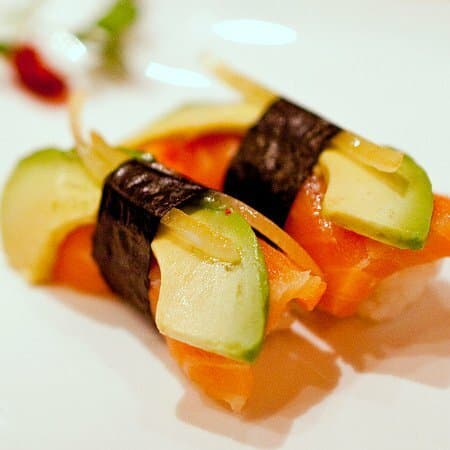Just when you were feeling good about finding your bread plate and salad fork at a business dinner, you find yourself in unchartered culinary waters: the sushi bar.
Yes, it's a foreign experience (literally!), but don't worry—the adventure is part of the fun! Even if you’re not yet sure the difference between “nigiri” and “norimake,” these tips will help you get comfortable and enjoy the (delicious) meal.
Where You Eat
First things first: Pick a seat. Your seating selection should hinge upon what you hope to accomplish during the meal. If you’re looking for a more casual outing, sitting at the sushi bar can offer a fun experience, since you can watch the sushi chef at work. But if you need to focus on business, a table will offer privacy and be more conducive to shop talk.
Diane’s Tip: Never order drinks or other non-sushi items from the sushi chef. The chef is held in the highest of regards in a sushi establishment and only handles sushi mainstays. He does not pour drinks, make change, or serve miso soup.
What You Eat
Sushi and sashimi will make up the majority of the menu in a sushi restaurant, each with endless variations and ingredients. What’s the difference? Sushi is generally a fish (sometimes raw, sometimes cooked) and vegetable filling surrounded by sticky white rice shaped into a roll, then wrapped in seaweed, fish eggs, and other accent ingredients. The rolls are then cut into bite-sized pieces that can be shared. Sashimi is simply fresh, raw fish that is served by itself or on top of a small portion of rice.
What Goes With It
Soy Sauce
When you dip your sushi or sashimi in soy sauce, aim to have the fish hit the sauce—dunking the rice will absorb too much of the liquid, and you’re likely to lose part of your roll. Plus, soy sauce is meant to enhance the fish, not the rice.
Diane’s Tip: Go light. Overindulging in the soy sauce is akin to pouring ketchup on an expertly prepared steak.
Wasabi
The little green blob is a fiery hot paste that will spice up your sushi, but should be eaten with some caution. Either take a small amount and put it directly on your sushi, or mix it into your soy sauce. But be careful—it’s powerful stuff that’ll definitely clear your sinuses!
Ginger
Along with wasabi, you'll be served thin slices of pink or orange-colored ginger with your sushi. The proper technique is to eat a small amount between bites to cleanse the palate. It's not meant to be eaten on top of the sushi; however, if you enjoy it, or your guests prefer to eat it in that manner, go right ahead.
Sake
Sake is a rice-based Japanese alcoholic drink that can be served cold, warm, or hot. The temperature of the sake is indicative of the quality: the colder the sake, the better the quality. Do keep in mind that the alcohol content in sake is comparable to wine, so drink accordingly.
Diane’s Tip: Traditional sake custom dictates that you should always pour sake for another. When pouring sake for friends, an overflowing cup of sake is traditionally a sign of an overflowing friendship. You don't have to do this at a restaurant, but you'll surely impress your colleagues with your sake knowledge if you do!
How You Eat It
The Towel
Eating with your fingers is expected, so you may be served a hot towel to clean your hands before your meal. After wiping your hands, gently place the towel back on the plate that the server presented it.
Chopsticks and Forks and Fingers, Oh My!
You’ll be given chopsticks with your meal, but if you're not comfortable using them, it's fine to ask for a fork. That said, don't be afraid to try: it will show your guest that you’re a good sport. It’s also perfectly acceptable to eat sushi with your fingers, but sashimi should be enjoyed with chopsticks or a fork.
If you’re served soup without a spoon, drink it from the cup and use your chopsticks or a fork to eat the solid items. Edamame (boiled soybeans served in the pod), on the other hand, is always eaten with your fingers. Hold the end of the pod between your teeth and squeeze the beans into your mouth with the index finger and thumb, discarding the shell.
One Bite or Two?
Sushi should be consumed in one bite unless it’s so big that you feel the need to break it into two pieces (the seaweed can prove tricky to cut through, though!). While the general dining rule is usually "don't take too large a bite," no one will judge you for opting to take a larger bite instead of struggling with a disintegrating piece of sushi.
Sharing
When sharing a meal at a Japanese restaurant, it is common to share family portions from a communal plate.
Diane’s Tip: Use the opposite end of the chopsticks (the end you haven’t put in your mouth) to transfer food between plates.
Venturing into the unknown world of chopsticks and raw fish can be daunting, but as long as you approach the experience with a sense of adventure, your meal will be a success. And if you’re worried about getting the hang of it, practice with friends before hitting the sushi bar with important colleagues or clients. Above all, have fun and enjoy!

